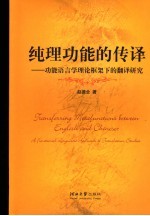

纯理功能的传译 功能语言学理论框架下的翻译研究PDF电子书下载
- 电子书积分:10 积分如何计算积分?
- 作 者:赵德全著
- 出 版 社:保定:河北大学出版社
- 出版年份:2007
- ISBN:7810971859
- 页数:202 页
Chapter 1 Introduction 1
1.1 Introduction 1
1.2 Theoretical bases 3
1.2.1 Systemic analysis on attempted texts 3
1.2.2 Traditional Chinese translation theory 4
1.2.3 Contemporary western theories 6
1.3 The statement of the problems 7
1.4 The goals of the study 8
1.5 The scope of the study 10
1.6 Procedures 10
1.7 The outline of the study 11
Chapter 2 Faithfulness and Equivalence 14
2.1 Introduction 14
2.2 Faithfulness 15
2.2.1 The early concept of faithfulness in translation 15
2.2.2 Xuan Zang's faithfulness 16
2.2.3 Translation practice following the Tang dynasty 18
2.2.4 Yan Fu's faithfulness 19
2.2.5 Translation theory in present China 23
2.3 Equivalence 26
2.3.1 Nida's concept of equivalence 26
2.3.2 Catford and translation equivalence 29
2.4 Systemic view on translation and equivalence 33
2.5 Summary 38
Chapter 3 Transferring Ideational Function 40
3.1 Introduction 40
3.2 Systemic functional perspective on languages 42
3.3 Metafunctions 42
3.4 Ideational functions and transitivity system 44
3.5 Preservation of ideational components 57
3.6 Ideational components in poetry 64
3.7 Shifts in translation 68
3.7.1 Order shifts 69
3.7.2 Rank shift 70
3.7.3 Structure shift 72
3.8 Summary 75
Chapter 4 Transferring Interpersonal Function 77
4.1 Introduction 77
4.2 Interpersonal function of language 79
4.2.1 Speech functions 80
4.2.2 Constituents of the mood 82
4.2.3 Constituents of the residue 83
4.2.4 Modality 86
4.3 Transferring interpersonal function 88
4.3.1 The interpersonal meaning in the ideational content 88
4.3.2 Prioritized interpersonal function 90
4.3.3 Transferring interpersonal function in opera translation 93
4.3.4 Transferring interpersonal function in novel translation 105
4.4 The balance between ideational function and interpersonal function 114
4.5 Summary 116
Chapter 5 Transferring Textual Function 118
5.1 Introduction 118
5.2 Textual function of languages 119
5.2.1 Theme and rheme 120
5.2.2 Given and new 124
5.2.3 Cohesion and coherence 126
5.3 Transferring textual function 128
5.3.1 Theme-rheme system in translation 129
5.3.2 Information system in translation 134
5.3.3 Focus-shifts in translation 140
5.3.4 Cohesion and coherence in translation 149
5.4 Summary 159
Chapter 6 Literal Translation and Free Translation 161
6.1 Introduction 161
6.2 Traditional concepts of literal and free translation 162
6.2.1 Early concepts of literal and free translation in China 162
6.2.2 Xuan Zang's strategy in Buddhist translation 164
6.2.3 Yan Fu—a practitioner of free translation 166
6.2.4 Lu Xu's adherence to the literal translation 168
6.2.5 Concepts of literal translation and free translation in western countries 169
6.2.6 Xu Yuanchong's summary on literal and free translation 171
6.3 Functional perspective on literal and free translation 173
6.3.1 Nature of literal and free translation 173
6.3.2 Automatization and de-automatization 177
6.3.3 Transferring ideational function:from literal translation to free translation 180
6.4 Summary 185
Chapter 7 Conclusion 187
7.1 Introduction 187
7.2 Questions involved 188
7.3 Major findings 189
7.4 Implications and applications 192
7.5 Limitations and suggestions 193
Bibbiography 195
- 《英汉翻译理论的多维阐释及应用剖析》常瑞娟著 2019
- 《当代翻译美学的理论诠释与应用解读》宁建庚著 2019
- 《程序逻辑及C语言编程》卢卫中,杨丽芳主编 2019
- 《社会文化系统中的翻译》姜秋霞,杨正军 2019
- 《2020考研英语大趋势 历年真题完形+翻译+新题型精讲精练》商志 2019
- 《幼儿园课程资源丛书 幼儿园语言教育资源》周兢编 2015
- 《高等学校“十三五”规划教材 C语言程序设计》翟玉峰责任编辑;(中国)李聪,曾志华,江伟 2019
- 《潜文本的阐释与翻译》刘早著 2019
- 《财经新闻翻译实践教程》胡婉,黄剑,王旭泉主编 2019
- 《功能涂料》刘仁主编 2018
- 《大学计算机实验指导及习题解答》曹成志,宋长龙 2019
- 《大学生心理健康与人生发展》王琳责任编辑;(中国)肖宇 2019
- 《大学英语四级考试全真试题 标准模拟 四级》汪开虎主编 2012
- 《大学英语教学的跨文化交际视角研究与创新发展》许丽云,刘枫,尚利明著 2020
- 《复旦大学新闻学院教授学术丛书 新闻实务随想录》刘海贵 2019
- 《大学英语综合教程 1》王佃春,骆敏主编 2015
- 《大学物理简明教程 下 第2版》施卫主编 2020
- 《大学化学实验》李爱勤,侯学会主编 2016
- 《中国十大出版家》王震,贺越明著 1991
- 《近代民营出版机构的英语函授教育 以“商务、中华、开明”函授学校为个案 1915年-1946年版》丁伟 2017
